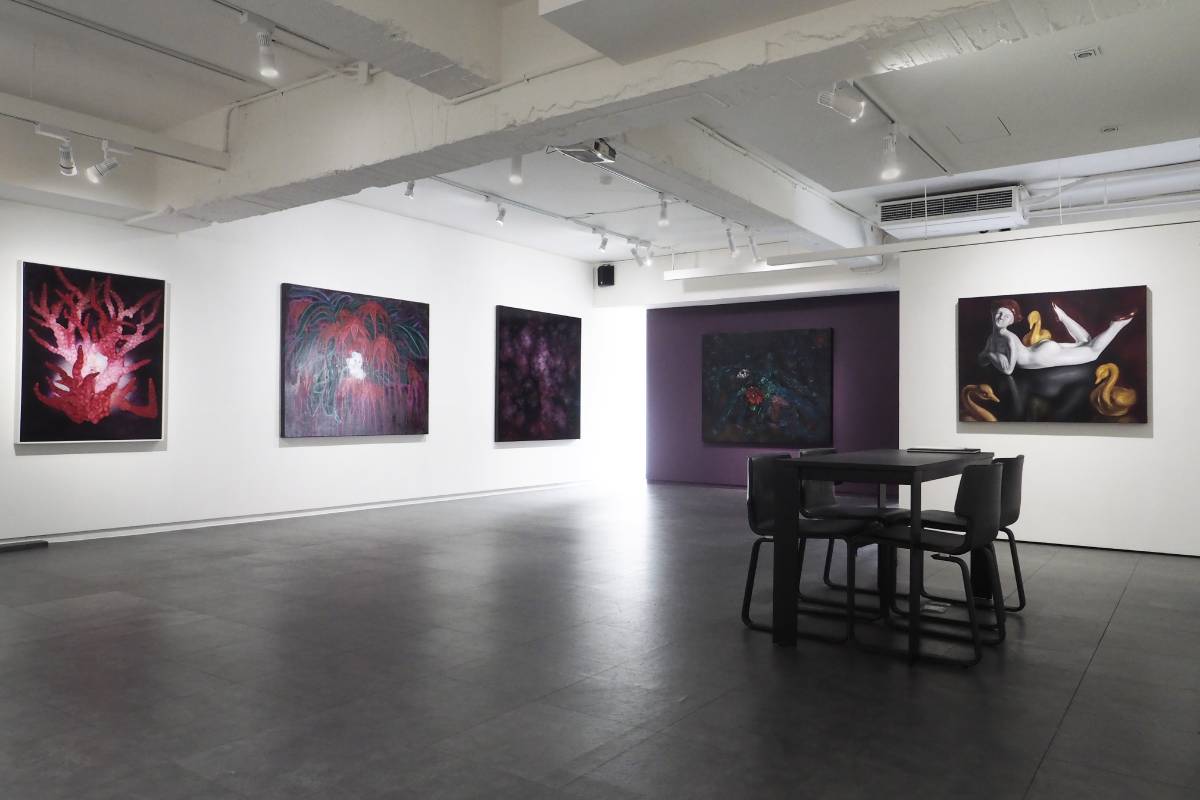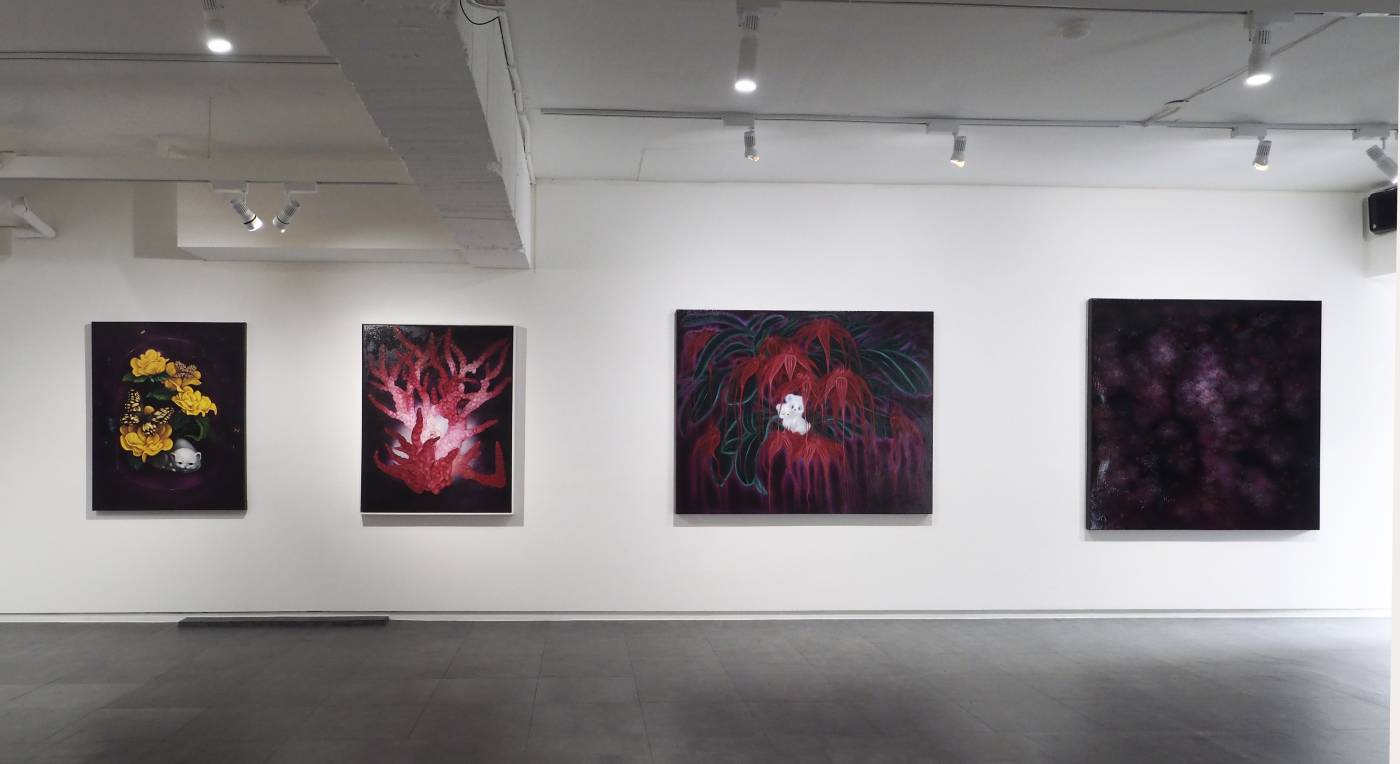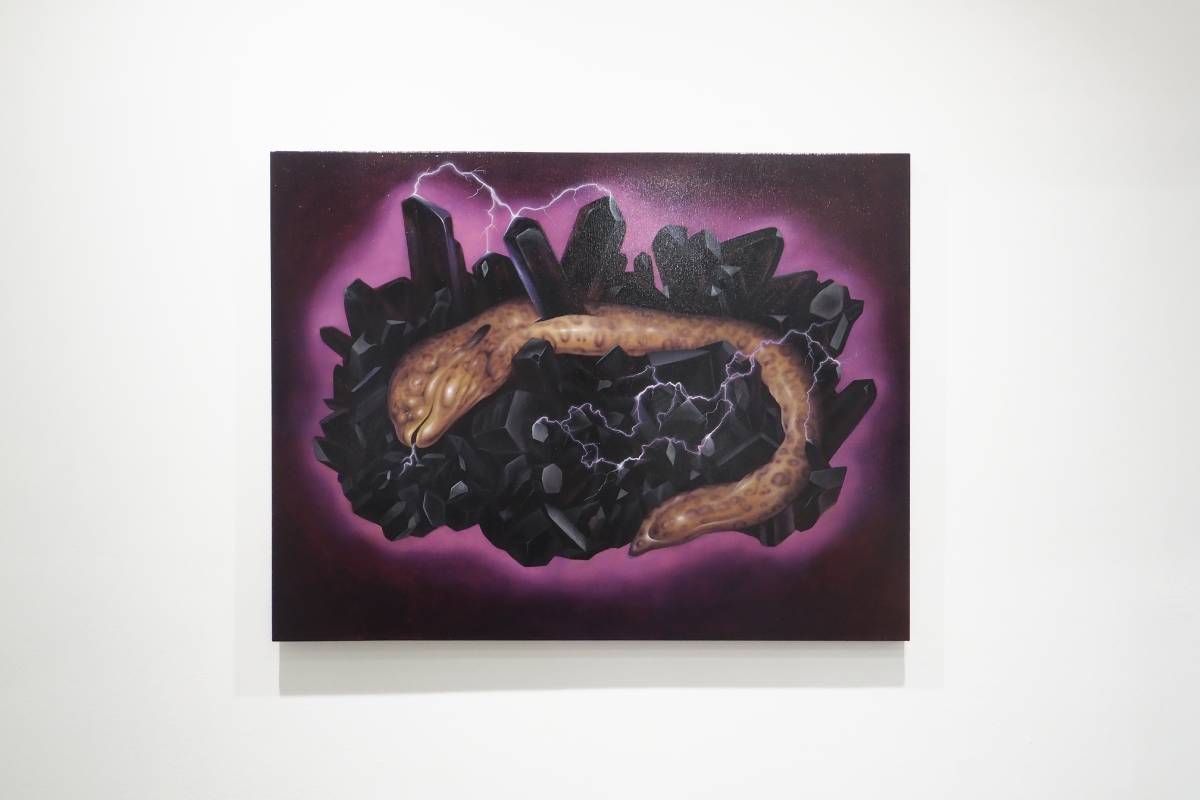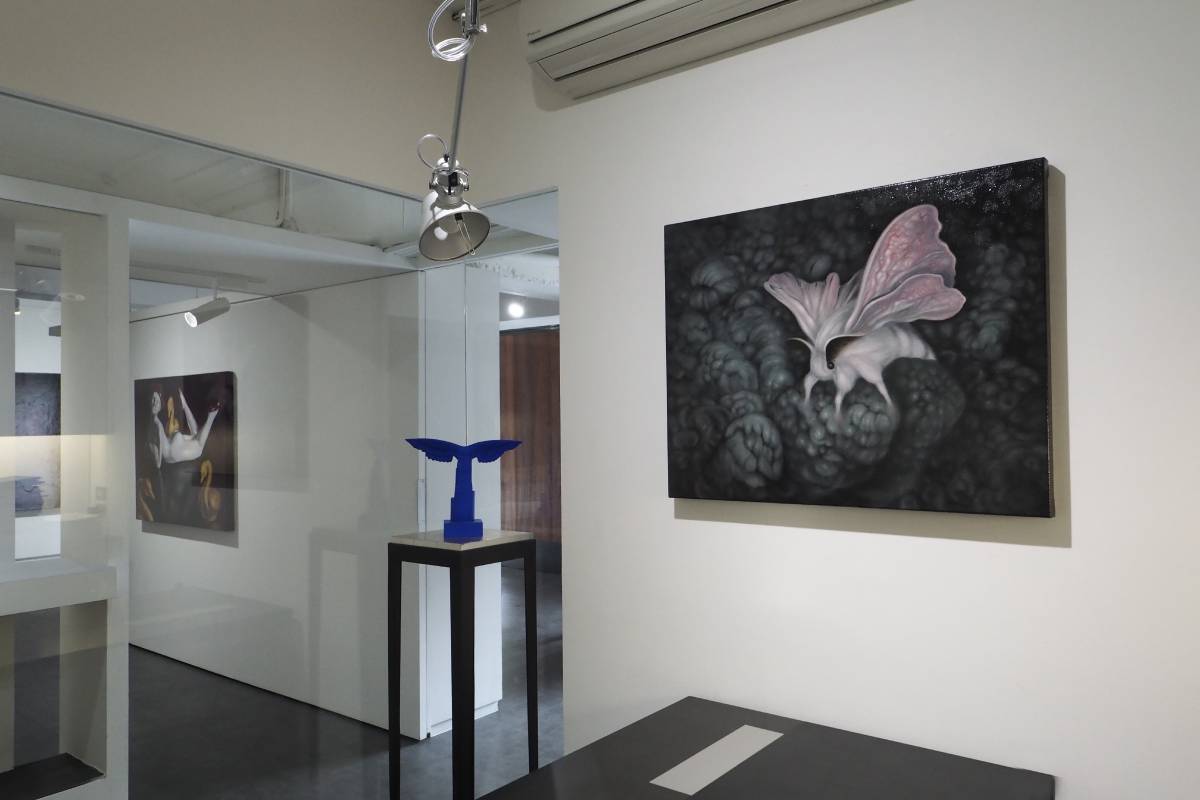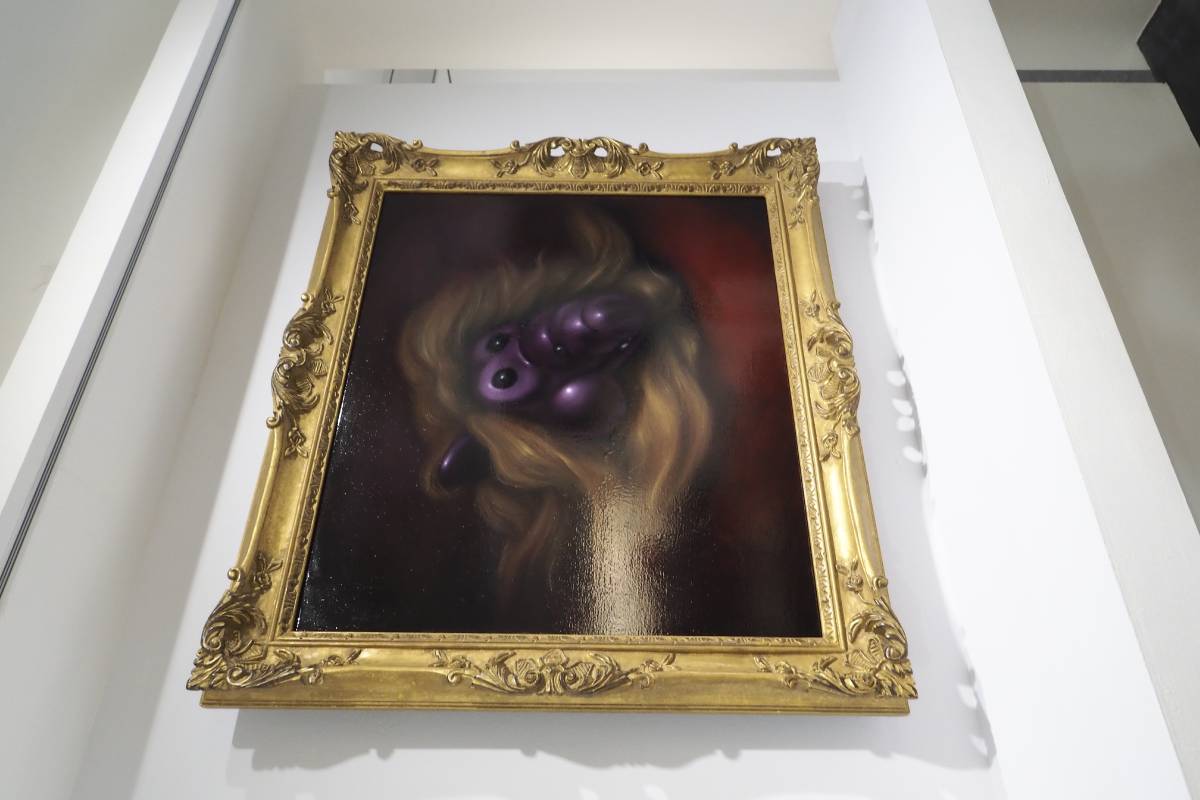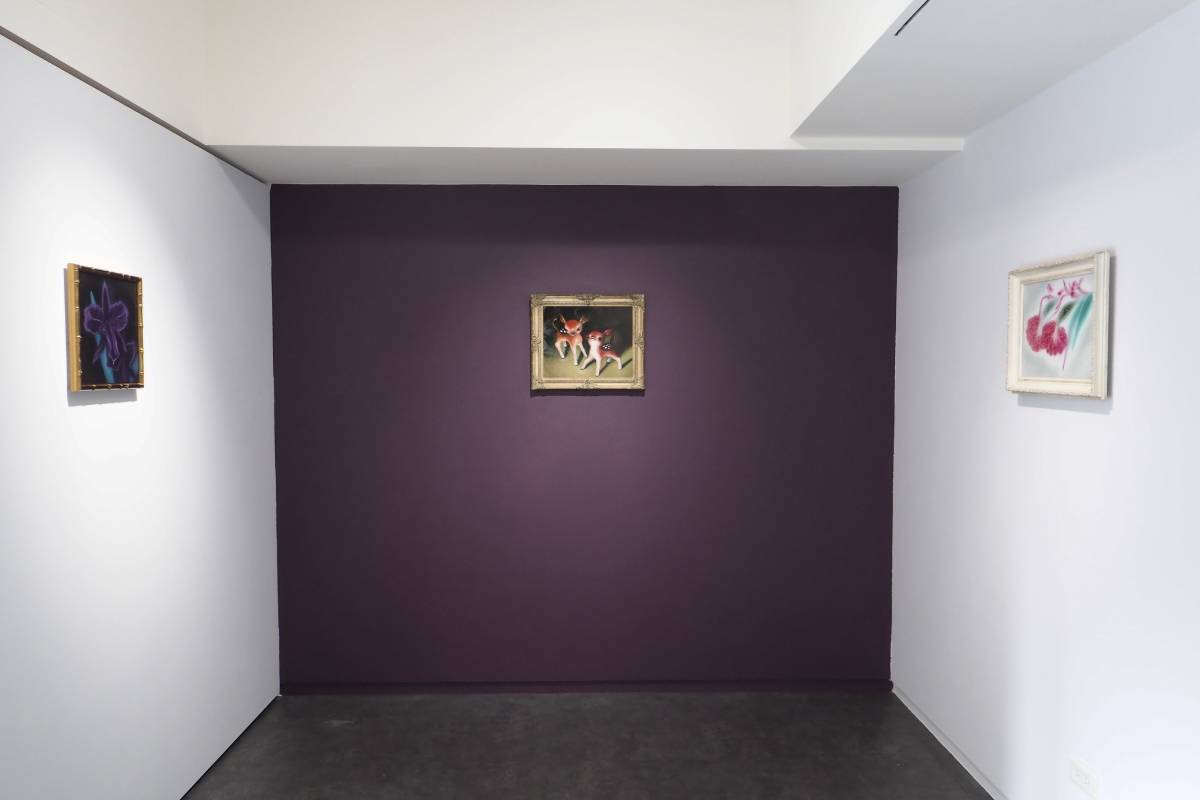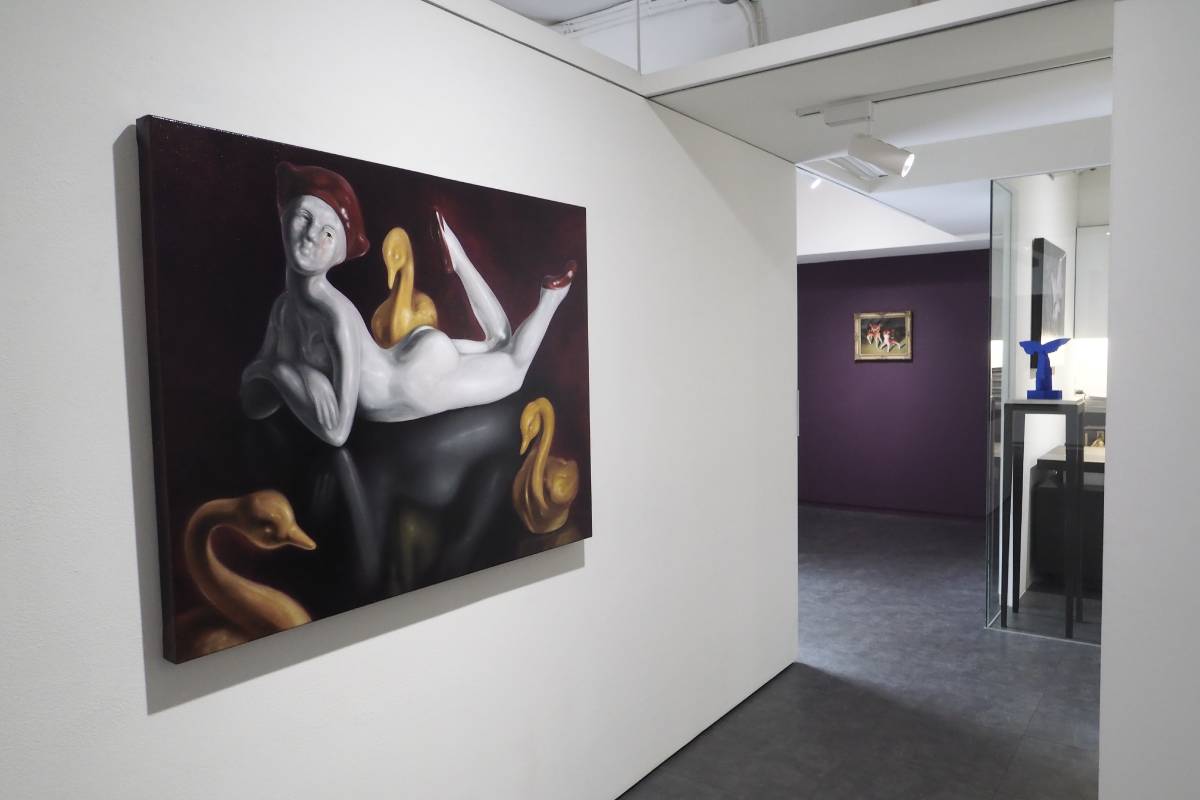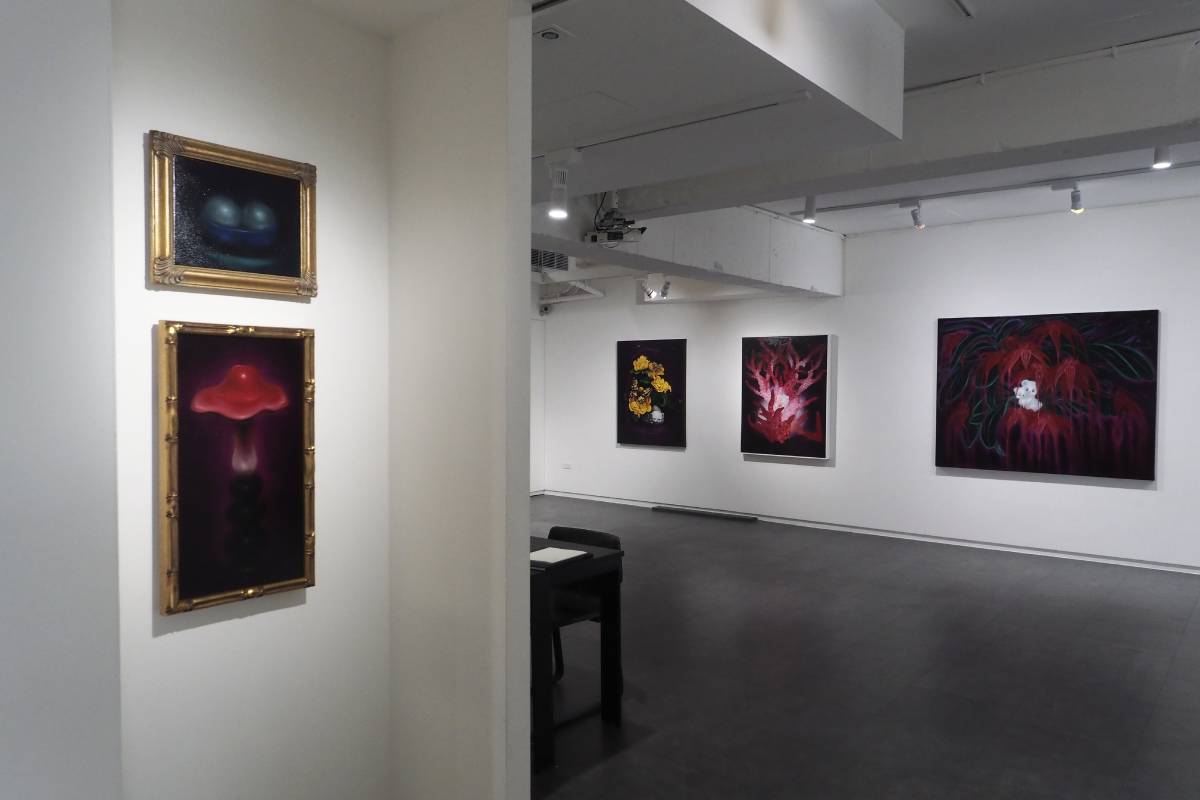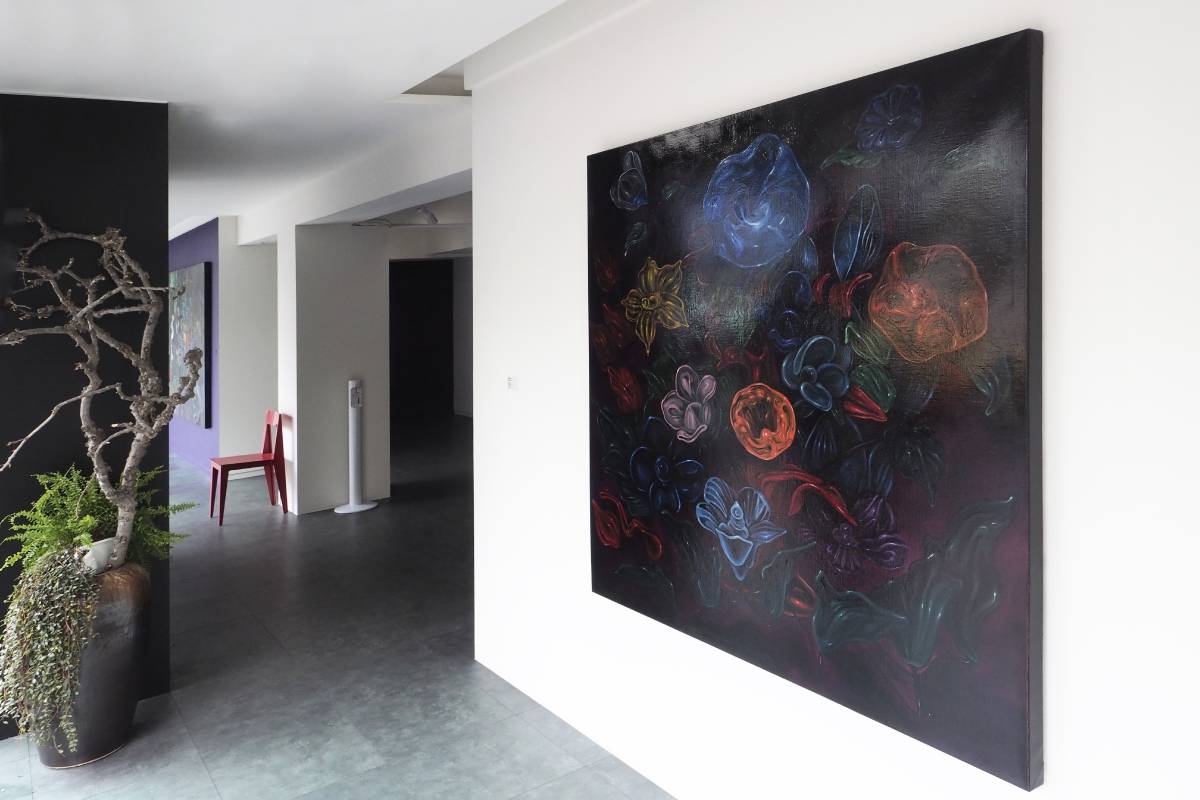赤粒藝術
【隱庇樂園The Sheltered Paradise】呂浩元個展Solo Exhibition of LU Hao-yuan
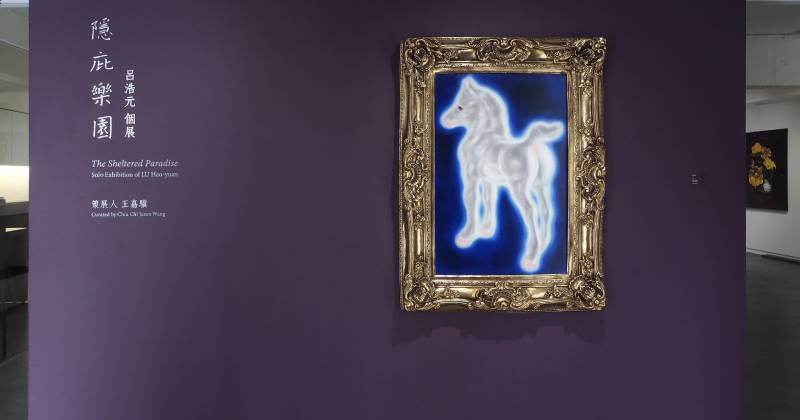
-
隱庇樂園:呂浩元的創作
王嘉驥
古羅馬詩人奧維德(Ovid)在《變形記》(Metamorphoses)史詩當中,敘述了一位名為皮格馬利翁(Pygmalion)的單身漢雕刻家,運用絕佳技法,創造了一尊令自己墜入情網的女性雕像。愛戀到難以自拔,他向愛神維納斯獻祭並祈願,期盼雕像成為他的美嬌娘。眾神眷顧他,最終讓他如願,冰冷白皙的雕像霎時轉為溫暖柔軟的胴體。兩人終成眷屬,維納斯女神也親臨婚禮。
「變形」的確是古希臘與羅馬神話時有所見的主題。常見的是,神將人石化──那是嚴厲的懲罰,等於死亡。或者,神將令其不悅的人變形為動物。皮格馬利翁的故事相對罕見,是眾神應允藝術家的請求,將後者擬造的無生命形體轉化為真人。不管是哪一種變形,都投射了欲望,神或人皆然。
呂浩元玩物多年,搜集各式各樣的人物或動物形象,尤其偏好富含情色意味的瓷偶。這類挑情物件屬於通俗文化的流行,來源眾多,反映的癖好不拘一時一地,異國情調往往不在話下。偶的造型與姿態也許只是短期的風尚,其深層蘊涵或投射的人性欲求,卻始終帶著普遍性。呂浩元將原本非屬純粹藝術範疇的瓷偶再現於他的畫中,不僅栩栩如生,更凸顯瓷偶光滑柔細的明亮外觀。
儘管蒐羅多年,藏納在他匣櫃內的觀賞物件,直到近年才成為他再現的對象。從裸露姣好軀體,挑逗意淫情趣的女性玩偶,到令人直呼可愛,惹人愛憐,或是饒富魅力,別具風姿的動物瓷像,都是他的主題。玩偶物件成為呂浩元近期常見的靜物題材,同時勾喚了一種既世俗,卻又不乏神祕與詭奇的氣息。這些昔日的物件入畫以後,沒有意外地引人懷舊之感。雖然是通俗,甚至量化生產的擺設品,卻因為藝術家在畫中的獨特對待與處理手法,散發出迷人的光暈,成了名副其實的「欲望之物」(objects of desire)。
為能逼真再現瓷器表面的光滑亮感及其圓潤的立體凹凸,呂浩元改變了初期的油彩厚塗風格,從強調筆觸肌理的表現主義,逐漸地趨向古典寫實技法,有時甚至能讓觀者產生誤以為真的錯覺(trompe l’oeil)效果。到了後來,即使他畫中的人物或動物形象,並非取材自瓷器玩偶,他依然賦予仿若雕塑的質感。 與上述的皮格馬利翁恰恰相反,呂浩元儘管將瓷器玩偶的眼神、形體、質感描摹得呼之欲出,但他似乎更樂於維持這樣的視覺弔詭,寧可將不言明的人性、本能、欲望封存於瓷器的物形之中,而不祈求將其真實化。與其掀開潘朵拉的盒子,呂浩元與他的欲望之物維持了一定的美感距離,而不耽溺。
帶有暗示性,卻不一語道破,欲求與渴望經常以一種精神意淫的形態,潛行在呂浩元畫作的細節內裡,或是藏蹤於隱蔽之處。相對地,由植物所構成的叢林或花園,於是成了庇護人類想望的另類伊甸樂園。初期的階段,植物只是位於起居空間某個角落的盆栽,或是桌上用於點綴生活趣味的瓶中擺飾。逐漸地,植物開始蔓延,展現生長的欲望,甚至佔滿了畫面。呂浩元對於開花類型的植物尤有好感。而花實際就是植物的生殖器官,盛開的花朵給人旺盛的生命力與繁殖的聯想。
盤踞畫面的植物構成了一個遺世獨立而自給自足的世界,藝術家將他的欲望之物安置其中,營造了棲居邊陲的安逸氣息。表面看起來平和與偏安,呂浩元卻也經常在叢林或花園深處,預設潛藏的不安與危機,戲劇性地強化畫中的人物與動物亟需保護的心理氛圍。的確,即使身在世外桃源,死亡的威脅依然如影隨形。對比於張揚的植物,棲居其間的人物或動物,反而顯出了弱小之感。畫家細心照拂這些瓷偶,呵護其柔細光鮮的外表,彷彿深怕毀傷。
無論是確有其形的瓷偶,或是將人與動物的意象瓷像化,畫家如實地將這些物件或擬仿的形象,化身為欲望的載體,尤其不乏情感與情慾的投射。出現在呂浩元畫中的形象,如若不是嫵媚嬌嬈的女性,也是楚楚動人的動物,往往帶著一種情色挑逗的意趣,有意無意地擾動觀者的道德尺度。植物本身也許不具意識與思考能力,但爭奇鬥妍的花展現了其與生俱來的繁衍本性。透過植物與花的圖像,呂浩元彷彿以一種隱喻的方式,暗示人性更底層的欲力或生殖衝動。
呂浩元近期熱衷於蒐集原礦,包括孔雀石、瑪瑙、水晶、魚眼石、預言石(褐鐵礦)、沸石等,都是他工作室桌面上常見的物件。寶石與占星的關係其來有自;水晶形態的能量石,據說具有療癒身心的作用,也是世界各地流傳千年以上的看法。並未迷信於占星或民俗療法一類的學說,具體讓呂浩元感覺著迷的,還在於原礦自身,因於特殊的地質條件,所形成的奇妙質地與紋理。
雖屬無生物,地層中的岩石與地球共生,經歷千萬年以上的地殼變動和累積,同樣有其孕育和成長的模態。細覷原礦的外貌及其剖面呈現的紋路,也許參差不齊,但充滿有機變化,冥冥中存在生長秩序,實際卻無定形。造物者的旨趣儘管難測,藝術家倒是透過自己所藏的各種樣本,看出了耐人尋味的自然美感,進而成為他最新的繪畫主題。在此,來自地層內部的原礦造形與其紋路,轉化為一個難以言喻的宇宙,讓人感覺無名、未知、離奇而神祕。相較於先前所見的植物花園,呂浩元創造了一個彷彿歸返到更為初始狀態的混沌世界。面對這個全新的象限,他有了更大的時空,可以繼續描繪個人的創世紀敘事。
The Sheltered Paradise: The Work of LU Hao-yuan
Chia Chi Jason Wang
In his epic Metamorphoses, the ancient Roman poet Ovid tells of a single sculptor named Pygmalion who, with immaculate skills, creates a woman statue with whom he falls in love. Smitten with infatuation, he makes his offering at the altar and prays to to Venus, the goddess of love, to bring the statue to life and make her his beautiful bride. In answer to his heartfelt prayer, the goddess turns the cold ivory statue into life, her body warm and soft to the touch. They unite in marriage, and Venus attends their wedding.
“Metamorphosis” is a recurring theme in ancient Greek and Roman mythology. It is common for the gods to petrify humankind – a severe punishment tantamount to death. Sometimes, the gods transform a displeasing human into an animal. The story of Pygmalion is relatively rare in which the gods grant the wish of an artist by bringing the inanimate creation of the latter to life. Whatever the form of metamorphosis, all are projections of desire in gods and humans alike.
Over years of artistic adventure with objects, Lu Hao-yuan has collected a miscellany of human and animal images, with a particular relish for porcelain dolls with erotic connotations. As mirrors of popular culture, these sensuous objects have come from varied sources. They are mostly exotic, reflecting fetishes of all times and places. While the shapes and postures of the dolls might look like a fleeting fad, the human desires subtly entailed or projected are always universal. In his paintings, Lu represents porcelain dolls, not purely artistic in nature, in a way that not only breathes life into them, but highlights their smooth, delicate and glistening appearance.
Despite years of collecting, only until recent years have the ornamental objects stored in his cabinets become his subjects of representation. They span from beautifully nude, tantalizing female dolls to porcelain animal figurines that are either lovely and adorable, or charmingly alluring. The dolls and figurines, which have been prevailing in Lu’s recent works as still-life subjects, evoke a secular ambience not without a mysterious peculiarity. These old objects in his paintings have undoubtedly evoked a sense of nostalgia. Commonplace or mass-produced as the ornaments are, the artist treats and handles them in such a distinctive way that transforms them into “objects of desire” with an entrancing glow.
To realistically represent the smooth and shiny surface of and rounded, three-dimensional quality on the ceramics, Lu has demonstrated a shift from his earlier style of thick oil painting. He has gradually switched from expressionist brushstrokes and texture to classical, realistic techniques, sometimes giving the viewers the illusion of trompe l’oeil. So much so that there is a sculptural quality to even the figures and animals not represented from real porcelain dolls in his paintings. Unlike Pygmalion, Lu seems to relish the idea to preserve the visual paradox, while portraying their eyes, forms, and texture with great vividness. He prefers to keep the unspoken human nature, instinct and desire sealed in the physical form of the ceramics, rather than turing them into life. Instead of opening the Pandora’s box, Lu maintains an aesthetic distance from his objects of desire without indulgence.
Suggestively and implicitly, desire and longing often lurk in the details or hides from sight in Lu’s paintings in the form of erotic fantasy. In contrast, a jungle or garden of plants become an alternative Eden, a haven for human desires. In the initial stage, the plants were just potted in a corner of the living space, or contained in a bottle as delightful ornaments on the table. Gradually, the plants have begun to spread and show a desire to grow, ultimately filling up the scene. Lu has a fondness for flowering plants in particular. As genitals of plants, the flowers in full blossom are associated with exuberant vitality and reproductiveness.
The sprawling plants constitute an isolated and self-sufficient world, where the artist places the objects of his desire, creating a cozy, marginal atmosphere. While peace and partial tranquillity seem to reign, Lu often manages to conceal unease and danger deep in the jungle or garden, which dramatically reinforces the psychological needs of the figures and animals for protection in the paintings. Indeed, the threat of death remains ubiquitous, even in an Arcadia like this. Compared to the flamboyant plants, the figures and animals inhabiting it appear relatively frail. The artist takes great care of these porcelain dolls, attending to their delicate and lustrous surface as if fearing to leave traces of damage.
They can be porcelain dolls in a physical form, or human and animal imagery with a ceramic look. The artist has faithfully transformed these objects or image simulacrums into carriers of desire, where there is no lack of projected emotions and desires. The images in Lu’s paintings are either of enchanting, luscious women, or of temptingly cute animals. They have an erotic and inviting air about them, intentionally or unintentionally disturbing the viewers’ moral comfort. While the plants may not be capable of consciousness and thinking, the competing flowers exhibit a breeding instinct. Through the images of plants and flowers, Lu seems to suggest, in a metaphorical way, that there is an underlying desire or reproductive impulse in human nature.
Recently, Lu has nurtured a hobby of collecting raw minerals, ranging from malachite, agate, crystal, apophyllite, prophecy stones (limonite) to zeolites, which are commonly seen on his studio’s desk. The relationship between gemstones and astrology has its ancient origins. The idea that crystal-shaped energy stones have healing effects on the body and mind dates back to over a thousand years ago. Despite not being a devout believer of astrology or folk healing, Lu is fascinated by the enigmatic quality and texture of the raw minerals resulting from specific geological conditions.
Inanimate as they are, the rocks in the stratum have been symbiotic with the earth. Having undergone crustal movements and accumulation for more than ten million years, they have their own mode of birth and formation. With a seemingly disorderly quality to their appearance and cross-sectional lines at a closer look, the raw minerals demonstrate organic changes and inexplicable rules of growth without a definite shape. While the Creator’s intention remains a puzzle, the artist has noticed the intriguing natural beauty through the various samples in his collection, which becomes the theme of his latest paintings. With their distinct shape and texture, the raw minerals extracted from the earth have metamorphosed into an unfathomable universe characterized by anonymity, uncertainty, singularity and mystery. Compared to the plant garden as we have previously seen, Lu creates a chaotic world, a return to a more primitive state. As new quadrants unfold, he continues to conjure up a Genesis narrative of his own in a larger time and space.
推薦展覽
view all赤粒藝術
【遠山疎樹李茂成個展】Scattered Trees and Distant Mountains: Solo Exhibition of LEE Mau-cheng
日期:2024-06-22 ~ 2024-08-04|台灣,台北市
赤粒藝術
【自然與記憶梁兆熙2024個展】Nature and Remembrance: Solo Exhibition of LIANG Zhaoxi
日期:2024-05-04 ~ 2024-06-16|台灣,台北市

